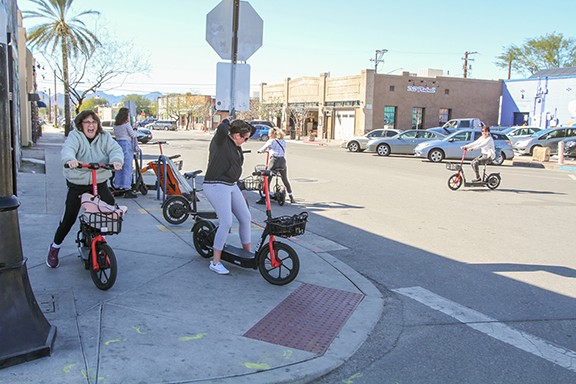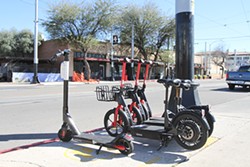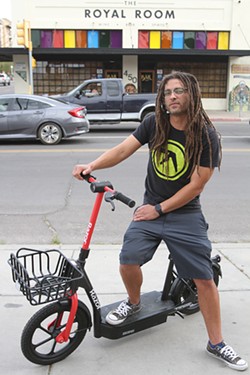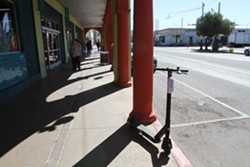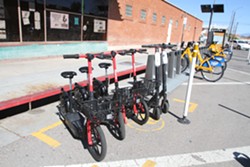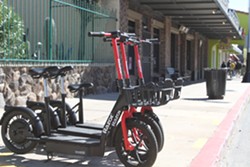Could he be there in 20 minutes?
"I started walking over to Owls Club and realized it was pretty chilly out. I saw a scooter and was like 'damn, might as well,'" Guido said. The City of Tucson's e-scooter pilot program was well into its six-month trial.
The 39-year-old freelance video producer downloaded the Bird E-Scooter app, scanned the scooter's code, heard it chirp and away he went down Stone Avenue toward Broadway Boulevard.
"I was buzzed, feeling good but not trashed. Everything was going good," he said.
As Guido started approaching the downtown intersection, the wheel of his scooter locked up and rocketed the auteur through the crisp night sky, straight into the cracked pavement. A police officer had a front row seat to Guido's unanticipated acrobatics while waiting for the intersection's light to turn green.
"As I slid across the asphalt. Initially I felt no pain...just immediate embarrassment because at the intersection, there were cars," Guido said. "I looked in the direction of the cop, waved it off, got on the scooter and rolled."
Waves of pain rippled through Guido's right hand once he arrived at Owls Club. He immediately checked the extent of his injuries in the bar's restroom.
"My hand was already swollen and purple, but luckily I didn't smash my face up," Guido said. "I didn't go to the hospital at first because I've had injuries in the past and I've let them mend themselves. Probably wasn't the wisest move."
The next morning his right hand resembled a ripe eggplant—in color and appearance. After paying $300 for X-rays at a nearby urgent care, Guido got his results: scaphoid avulsion fracture between his right hand's thumb and forefinger and an extra-articular proximal phalanx fracture of the small finger.
In layman's terms, Guido suffered two fractures to his right hand, which ultimately resulted in the loss of 50 percent of his dominant hand's strength. The hurt appendage was in a cast for five weeks. To add insult to injury, Guido then had to go through another five weeks of physical therapy. His right hand is now back to 70 percent of its previous strength.
Guido was unable to work during the five weeks his hand was in a cast. The situation was a "complete loss of work," which led to a "complete loss of money," he said.
"I feel like it was a poor decision on my part to get on a scooter after a handful of drinks," Guido said. "However, I think the accessibility of these scooters is wrong. They're everywhere and anyone can ride off on these things if they've been drinking or not."
Scooting by Numbers
Earlier this week, Tucson
Mayor Regina Romero and the city council reviewed the Tucson Transportation and Mobility Department's E-Scooter Pilot Program Report during their March 3 study session. Last September, the city awarded Bird and Razor electric scooter companies permits to operate fleets within city limits. The program allows each company to leave up to 500 e-scooters on city streets, with the option to deploy an extra 250 in low income and transit-dependent communities.
The six-month pilot program is scheduled to end March 12, if the mayor and council vote not to continue.
The city's report is based on five months of data collected from program financial reports and a community involved online survey, as well as e-scooter related injury data collected by Pima County Health Services. The online survey was available on the City of Tucson website from Dec. 10 through Feb. 1. The survey's sample size was over 2,700 residents.
More than 37,000 Tucsonans and tourists have taken almost 174,000 e-scooter trips between the program's start on Sept. 12 through Feb. 12, according to the report. The daily average is 1,130 trips per day, with the average trip distance about .86 miles and the average trip duration was about nine minutes.
"That's pretty encouraging, showing there's certainly demand for short trips in our urban corridor," said Andy Bemis, Bicycle and Pedestrian Coordinator for the City of Tucson Transportation and Mobility Department. "Most importantly, we're finding out what type of trips they are replacing."
According to the report, the City of Tucson's online survey asked the question, "If a scooter wasn't available, how would you have gotten around?" The number one answer was "walked" with 36 percent of the vote, followed by "personal vehicle or car share" with 24 percent.
"There clearly seems to be a demand for a low cost, quick, short trip option in Tucson we didn't have before," Bemis said. "If (the program) stays around, the biggest benefit is just providing more transportation."
Ridership started strong in the program's opening month with nearly 43,000 trips during September and peaking at 55,500 trips in October. However, e-scooter trips dropped significantly in November to nearly 35,000 trips. Ridership continued to fall in December with a little under 20,000 trips. January saw an increase of over 2,500 rides from the previous month, bringing the monthly total to about 22,000. In a nutshell, there was nearly double the number of riders during the program's first month as there were in the last month.
On any given day during the program, there was an average of 688 e-scooters on Tucson streets, mainly in central Tucson's Ward 6—the most populated area of the city.
"Primarily, these trips are happening in the downtown area, Fourth Avenue, and the UA area," Bemis said. "About half the trips are in Ward 6."
Blight Club
Ward 6 Councilmember Steve Kozachik has been outspoken in his opposition to the e-scooter program from the start. With the increase of ridership during the first few months, Kozachik said he received an increase of complaints from business owners and community leaders about various e-scooter issues.
"I thought the program was a mistake to begin with," Kozachik said. "Every jurisdiction not only domestically, but internationally has seen the same kinds of things we're seeing. The clutter, the injuries, the sidewalk riding, no helmets. It's not a surprise."
In fact, e-scooter parking is the top issue for 86 percent of respondents to the city's online survey, according to the program's report.
"Bill at the Shanty has them hung up on his metal railing. Mr. Heads has (e-scooters) piled up in rows of five right outside their place," Kozachik said. "Antigone Books has them laying in front of their door where customers have to step over them to get inside."
Bill Nugent, owner of The Shanty, confirms his conversation with Kozachik. He said his staff are having to move the e-scooters away from the bar's wheelchair ramp and loading dock on a near-daily basis.
"Yeah, they're cute and the kid's love 'em but the truth of the matter is they are causing a lot of problems for us," Nugent said. "We had to move six (e-scooters) last night because they're all over our sidewalk and blocking our handicap ramp."
Across downtown at Owls Club, bouncer Rio Finnegan faces a similar problem. While he said he wants to like the program, Finnegan admits he is a bit cynical about it. He has a good reason: Finnegan was born with spina bifida and uses a wheelchair.
"It's hard because I work graveyard shift a lot as a bouncer and I see the use of them a lot after midnight," Finnegan said. "People just leave them where they leave them, you know what I mean? They just trash 'em."
Finnegan said he gets annoyed having to move e-scooters out of his way after work, but he can still do it. He worries about people with disabilities that can't move them.
"It's kind of a bummer. Let's say someone in a wheelchair is quadriplegic riding down the sidewalk and all of the sudden two Razors or Birds are blocking them," Finnegan said. "They can't move the scooters because they don't have the use of their arms. It's hard because in those cases it's just carelessness."
Fred Ronstadt, executive director of the Fourth Avenue Merchants Association, has also been bombarded by complaints about e-scooters from business owners and workers in the area. Ronstadt said he shares their irritation toward the program.
"It's been incredibly frustrating. All of the challenges we predicted in the beginning are happening on a regular daily basis," Ronstadt said. "E-scooters being left in the middle of the road, on sidewalks, on wheelchair ramps. It's top-to-bottom frustrating."
Ronstadt stopped speaking and pointed across the street as we stood in front of The Shanty, on the corner of Fourth Avenue and Ninth Street.
"In fact, there's a scooter that's in the middle of that sidewalk now," said Ronstadt, shaking his head with an exasperated smile. It was laying next to one of the city's newly designated parking spaces for e-scooters.
"How hard is it for somebody to see this yellow box and still park their scooter just a few feet away?" Ronstadt said. "They're not doing it."
After nearly three months of complaints from his constituents, Kozachik called a study session with the mayor, council, transportation officials and the two e-scooter companies.
"I had about 150 different slides of scooters all over the place and I showed them one at a time," Kozachik said. "Correcting the issue was not something Bird or Razor offered to do from the onset. It was something they did to preserve their program and I made them look stupid with all the images."
After the December study session, Kozachik, Ronstadt, Bemis and representatives from both e-scooter companies walked Fourth Avenue to identify potential parking areas between Ninth Street and University Boulevard. The city paid for the new parking spaces and the e-scooter companies agreed to implement incentive programs to encourage riders to park properly. But just because there are new spaces and incentives doesn't mean riders actually use them.
Nugent's bar is located across from one of the new e-scooter parking areas. While parking is a step in the right direction, he said it hasn't really solved the problem—at least not in his neighborhood. Nugent said he doesn't understand why the e-scooter companies and their riders can't be held to more accountability.
"They're going out to pick up the scooters anyway. Can't (the e-scooter companies) just look at who used the scooter with their credit card?" Nugent said. "If someone doesn't put their scooter in a docking area, contact the rider and fine him $50."
The parking spaces and e-scooter enforcement have cost the city more than $20,000, according to Kozachik. The city has collected about $68,000 in fees (as of January 2020) from Bird and Razor scooters through application fees, permit fees and right-of-way-use fees (about 20 cents per trip), according to the report. The report also estimates the city would receive an extra $6,608 in fees as the pilot program winds down this month.
"It's not financial. We're not making money on it. That's not what it's intended for," Kozachik said. "The real goal for the mayor and council is to make us look green. Make us look like we give a rip about climate change."
It Ain't Easy Being Green
Both Razor and Bird e-scooters boast they are helping Tucson become more environmentally friendly by replacing car trips with e-scooter trips. In fact, Razor makes the claim that they've "replaced 830 car rides a day, saving 115,000 lbs. of CO2 from being emitted in the process" since the program's start, according to their December 2019 action plan submitted to the mayor and council. Bird also claims their e-scooters have "avoided over 31,000 lbs. of CO2 emissions" in their action plan, while giving no further information.
Both Razor and Bird representatives declined to be interviewed, but did agree to answer email questions. However, once the companies received the questions, they declined to answer those as well.
The eight questions asked to each company dealt with how they calculate CO2 emissions and vehicle displacement, how many Tucsonans use their incentives to park e-scooters properly, and what meaningful investments they've made in the community. (Razor said they are committed to making "meaningful investments" in Tucson. I asked them to highlight a few...but alas, no answer).
It should be noted Bird was nice enough to send bullet points of their December action plan in place of answers. Brandon Cheung, Razor's senior manager for government relations took the Fifth Amendment route offering nothing more than, "I wish I could be of greater assistance at this time." One would think that companies who say they are committed to being environmentally conscious community partners would be open to answering a few simple questions as to how they calculate their data.
When asked if e-scooters were reducing Tucson's carbon footprint, TDOT's Bemis said "It's a little early to tell. But yes, a non-trivial amount of trips seem to be replacing driving trips."
Lizzie Mead, owner of Silver Sea on Fourth Avenue, said she was intrigued by e-scooters once they first hit the streets. After a few rides, Mead liked them so much she decided to buy one during a Black Friday sale. She uses her scooter to get to work on days she's not bringing products to her shop, she said.
"I used one on the first day. I had to get on that thing and play with it," Mead said. "I was like, 'Why drive and worry about parking when I could just bring this into my shop?'"
Mead acknowledges her e-scooter experience is not average for most riders on Fourth Avenue.
"I think a lot of people aren't necessarily using it down here as real transportation, though" Mead said. "They did what I did at first. They saw them and went, 'I want to try that thing. It looks fun and dangerous.'"
Let's recall the data from the city's recent online survey, which had more than 2,700 respondents. The survey showed 36 percent of riders (972 people = 2,700 x .36) used a scooter in place of walking. Only 24 percent of those surveyed (648 people = 2,700 x .24) said they used an e-scooter in place of a vehicle or ride-share. While Bemis is right, nearly a quarter of those surveyed chose an e-scooter over a car, the data shows walking being replaced more than any other mode of transportation.
"There isn't a single environmental ordinance that I haven't supported," Kozachik said. "If there was a legitimate environmental argument to be made, you know I would be making it. This is not fixing the carbon footprint."
About 43 percent of the survey's respondents say they are an occasional e-scooter rider. The primary reason for most trips was for "social and/or entertainment" purposes at 26 percent and another 25 percent of those surveyed said they rode them "just for fun."
Kozachik cites the e-scooter companies' use of delivery vans that deploy the fleet of nearly 700 e-scooters on Tucson's streets daily, as a counterpoint to the environmentally friendly argument.
"The scooter employees are picking them up, taking them home and plugging them in, so that's electricity being used," Kozachik said. "I mean, it's not like they're plugging them into a solar array."
What bothers Kozachik most about this program, he said, is how it's presented as helping the environment from both the e-scooter companies and city officials. He said he wishes they could be honest with themselves and the community.
"If you want to make the argument that these things are cool, they're fun and let the people get around how they want, from a transportation standpoint, knock yourselves out," Kozachik said. "But you can't say they're saving the environment for all the reasons they give."
Safety First?
E-scooter clutter is just the tip of the iceberg of the program's problems, according to Ronstadt. Business owners on Fourth Avenue call him regularly about public safety issues due to Razor's and Bird's lack of enforcement of their rules and regulations, Ronstadt said.
"Last Saturday, I had to educate a family that were activating five scooters—two for the parents and three for their middle-school-aged kids," Ronstadt said. "They don't have helmets and you're supposed to be 18 years old to ride them. It's very frustrating."
Weekends show the strongest numbers in terms of e-scooter trips by day of the week, averaging nearly double the number of trips on a Saturday (about 1,675 trips) as opposed to ridership on a Monday (about 843 trips). Most trips tend to happen between noon and midnight on the weekends.
Ben Sattler, co-owner of Drunken Chicken, has witnessed issues caused by e-scooters on Fourth Avenue's sidewalks on weekend nights. Sattler said he thinks the program is a "potentially good idea" but questions the safety aspect.
"On Friday and Saturday nights, we're having bigger issues because people have less inhibitions, so they're cannonballing down the sidewalks," Sattler said. "We've had a customer walk out the door and get hit. The drunk guy got up, said, 'Sorry,' and scooted off."
E-scooters follow the same laws as bikes, meaning Tucson Police Department cannot issue a DUI for operating an e-scooter while intoxicated, according to Roi Lusk, assistant city attorney for the City of Tucson. Bikes and e-scooters are not considered vehicles under state law, Lusk said. However, police can still give tickets to people who ride e-scooters on sidewalks, just like bikes. Lusk did say "enforcement is dependent on staffing."
Like Ronstadt, Sattler also takes issue with the lack of regulation due to the speeds e-scooters can go. For example, Razors can speed up to 18 mph, according to their website. Sattler is no stranger to speed. He's been riding bikes and skateboarding since his youth. But even with his experience, he said e-scooters still feel unsafe.
"It's kind of surprising they let anyone with a phone app jump on and use it," Sattler said. "You can get up to speeds that would make me feel uncomfortable if I didn't have my biking or skating background."
The University of Arizona believes e-scooters to be unsafe. Campus officials banned e-scooter use on campus a year before the city's program started, according to Jim Sayer, executive director of transportation at the University of Arizona.
"The university simply felt that in the interest of safety for our students, employees and folks visiting our campus, we would not allow e-scooters," Sayer said. "We want the city's pilot program to be successful since they've decided to give it a shot. We're going to keep observing and hope to learn a little bit."
Sayer said the university does has a good relationship with Bird and Razor. The two companies have instituted geo-fences, which stop their e-scooters from being used on campus. The companies use the same technology during the Fourth Avenue Street Fair and Winterhaven Festival of Lights.
"I'll say from our perspective, the geo-fences have been highly successful," Sayer said. "Considering we've banned (e-scooters) on campus, (the companies) have been very accommodating adjusting geo-fences when we've needed it."
At the request of Kozachik, Bird donated a few cases of helmets to give to the public at the Ward 6 and the Fourth Avenue Merchant Association's office. Ronstadt said his office promoted a helmet give-away on social media, but still has plenty left. Only 10 people have stopped by for a free helmet, Ronstadt said.
Kozachik said he's unsure how many helmets his office has given away. He's seen a few takers, but there's a nearly full box at his door. He's not so sure everyone grabbing a free helmet is an e-scooter rider. "Nobody is riding up on a scooter and riding off with one," he said.
"The real proof is the amount of people still not wearing helmets on Fourth Avenue" Kozachik added. "If you go down and try to count the amount of riders wearing a helmet on one hand, you'll be there all day and night."
Fewer than 10 percent of respondents to the city's survey were concerned with issues over riding scooters or lack of wearing helmets while riding. The report also shows 71 percent of riders admitting to never wearing a helmet when they ride a scooter.
"You can give out helmets. You can paint parking spaces. You can create incentives to give discounts," Ronstadt said. "But the reality is you can't control the extent of human stupidity."
On that note, 87 percent of the same people surveyed also said they have "never fallen or crashed riding an e-scooter" and only 2 percent said they "required same-day medical attention at an urgent care or hospital.
Hit The Road, Jack!
Of all respondents surveyed,36 percent strongly disapprove of e-scooters in Tucson, while 26 percent strongly approve.
"This isn't just one or two complaints. It's not just Fred (Ronstadt). It's individual merchants. They're just done with it," Kozachik said. "It was nice, but at some point you got to know when to hold 'em and know when to fold 'em."
It's worth noting about 65 percent of the survey's respondents admitted to never riding an e-scooter, with another 33 percent saying they rode one once. Furthermore, when the vote is broken down to e-scooter users versus non-users, the results are drastically different.
More than 60 percent of those who considered themselves e-scooter users said they strongly approve of the program, with only 13 percent of users disapproving. For non-users, only 10 percent strongly approved of the program, while 44 percent strongly disapprove. In addition, 54 percent of users said they would be extremely likely to "recommend e-scooters to a friend" while 62 percent of non-users said they would not.
E-scooter boosters say that despite the complaints, the vehicles are going to be here in the future. Gabriel Flores, an employee at Food Co-op and Wooden Tooth Records on Fourth Avenue, said he rides e-scooters because "they're fun and cheaper than Lyfts." Flores said he views e-scooters as being an inevitable part of becoming a growing, modern city.
"You got to exercise your own caution on them, but they're fun." Flores said. "It's just small changes in (the city's) growth. You can either embrace the change or you can be the guy who knocks the scooter down because you don't like it."

